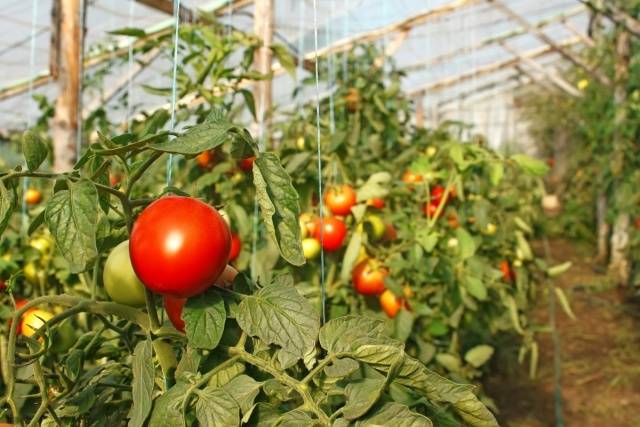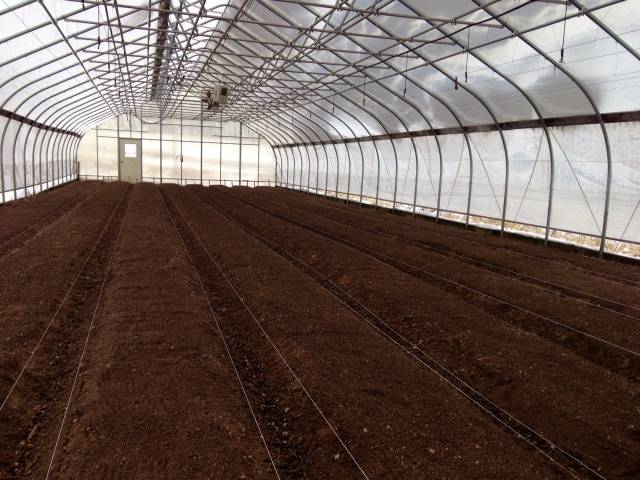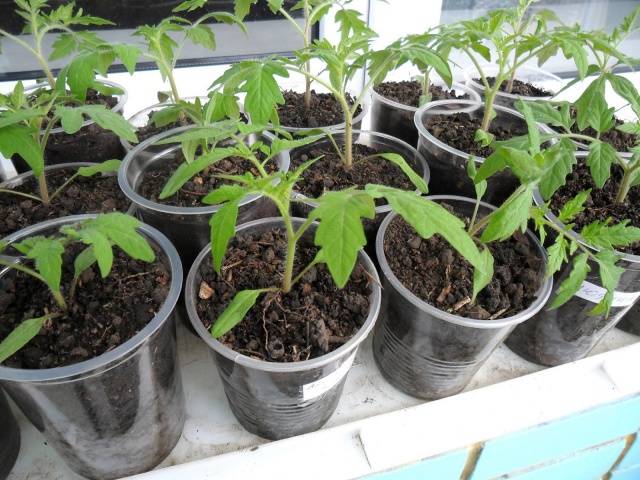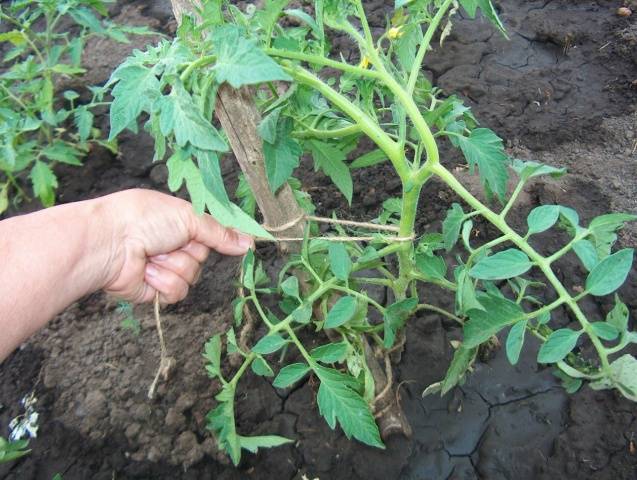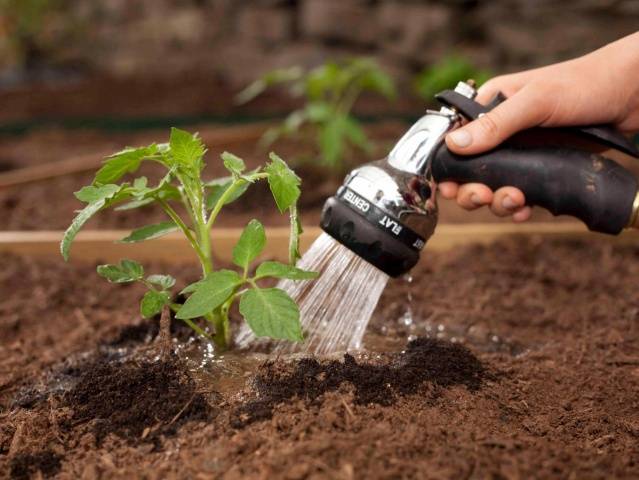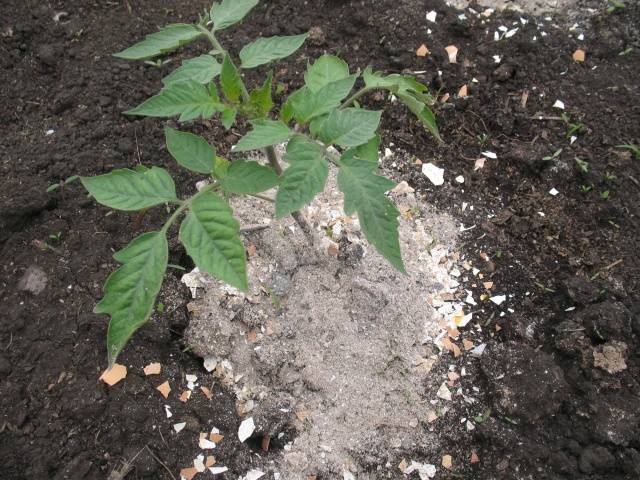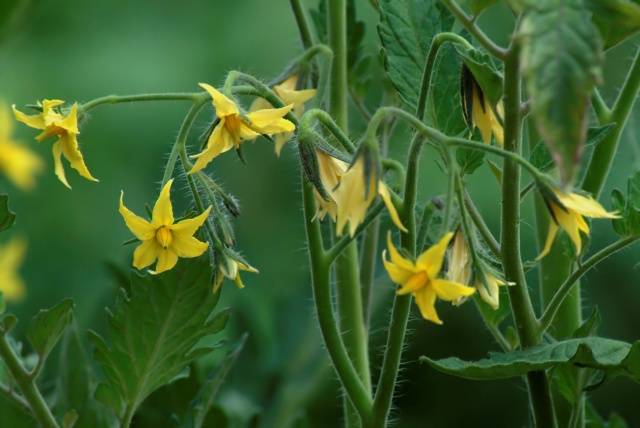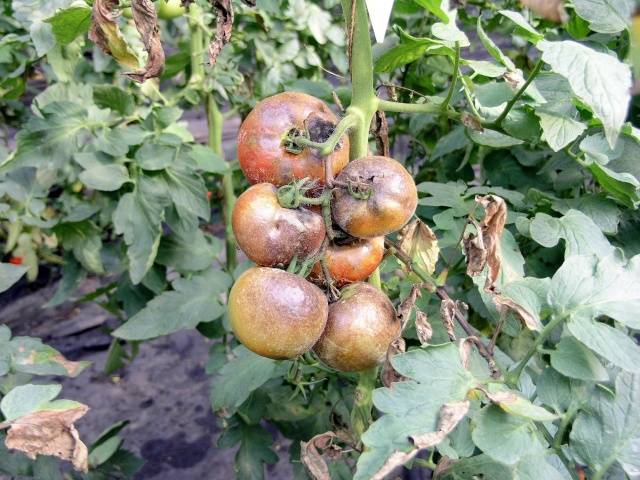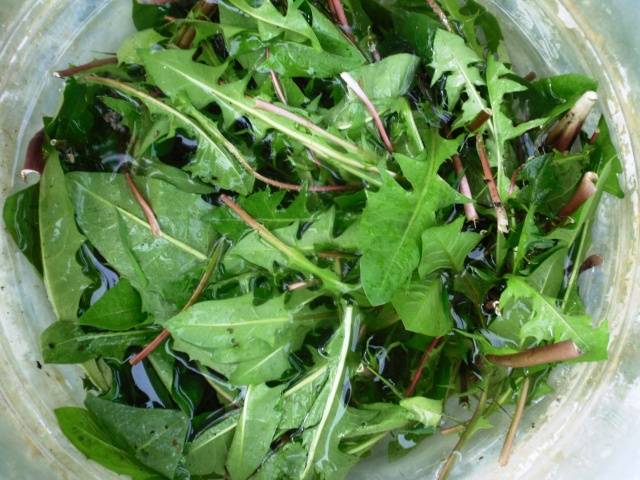Content
Growing tomatoes in the greenhouse made of polycarbonate includes a set of works, which includes preparation of the landing site, shaping seedlings and their transfer to a permanent place. After planting tomatoes in greenhouses, you need to follow the rules for watering and fertilizing.
Greenhouse preparation
You need to prepare a greenhouse for planting tomatoes a few weeks before planting plants. Usually, work begins after the snow melts on the site.
The greenhouse is placed in an open space well-lit by the sun. On the roof and side walls, it is necessary to equip windows for ventilation.
In the spring, the greenhouse is ventilated and wiped with a wet cloth. In order for the tomatoes to receive the maximum possible illumination, all dirt must be removed from the walls.
Soil preparation
Good quality soil provides plants with nutrients. Soil preparation for growing tomatoes in a polycarbonate greenhouse begins in the fall. For 1 sq. m of beds requires ash (3 kg), ammonium nitrate (0.5 kg) and superphosphate (3 kg).
Tomatoes prefer alkaline or neutral soil. The main indicators that the soil for tomatoes should have are high air permeability and porosity.
Work with the soil is carried out a week before planting:
- The top layer of soil is removed, since it contains harmful microorganisms and insect larvae.
- For disinfection, a weak solution of potassium permanganate is prepared, with which the soil is thoroughly watered before planting.
- Improvement of the soil structure for tomatoes: for clay soil, compost, peat and sawdust are used, for chernozem - compost and sand, for peat soil - turf soil, sawdust, compost, coarse sand.
- The introduction of potassium nitrate (5 g) and superphosphate (15 g) for each square meter of the beds.
- The soil in the greenhouse must be carefully dug up so that beds up to 0.4 m high and 0.9 m wide are formed.A free space of 0.6 m is left between the beds with plants.
Seed treatment
For growing tomatoes, high-quality seeds are chosen, without external defects. Material preparation begins at the end of February.
Seed processing is carried out in several stages:
- Tomato seeds are wrapped in cloth and placed in a potassium permanganate solution for 20 minutes. To prepare the solution, 1 g of potassium permanganate and a glass of water are required.
- 5 g of nitrophoska is added to 1 liter of water, after which the seeds are placed in the resulting solution. The container is left for 12 hours in a warm place.
- After the nutrient solution, plant seeds are placed in a container with water and refrigerated for 2 days.
- After the treatment, the seeds are planted on seedlings.
Seedling preparation
First, tomato seedlings are obtained, after which they are transferred to a greenhouse. Plants require containers with a height of about 5 cm. The soil can be taken from the greenhouse or purchased ready-made soil mixture.
The seedling growing technology includes the following order:
- The soil is poured into the container, which is watered and tamped.
- Small furrows up to 1.5 cm deep are made in the ground, where the seeds are placed. 7 cm is left between the rows with plants.
- The containers are placed in a warm place with good lighting.
Seedling care includes a number of actions:
- after the emergence of tomato seedlings, watering is carried out, which is repeated every two weeks;
- in the daytime, the temperature should be in the range from 18 to 20 ° С, at night - 16 ° С;
- the containers are turned daily so that all plants receive an equal dose of sunlight.
The plants are pinched, leaving 2/3 of the height, and transplanted into other containers. This procedure allows the seedlings to save energy for further flowering and fruiting.
Transfer to the greenhouse
Tomatoes are transferred to the greenhouse in the second half of May. First you need to change the temperature of the soil. Its value must exceed 13 ° C.
The transplant is carried out when the plant has 5 leaves and the root system has formed. The work is done in the afternoon. It is best to choose a cloudy but warm day.
Pre-formed holes with a depth of 20 cm. Pour 1 liter of potassium permanganate solution into each hole (with a concentration of 1 g per bucket of water).
The lower leaves of the tomatoes must be pinched off, then the plants should be placed in the holes and covered with soil. After 10 days, the bushes will take root, then they are poured to the lower leaves.
Microclimate in the greenhouse
For normal growth of a tomato in a polycarbonate greenhouse, the following conditions are required:
- Regular airing... In summer, under the influence of sunlight, the greenhouse heats up, which leads to drying out of the soil, wilting of tomatoes, falling off of inflorescences. To prevent a rise in temperature, the greenhouse must be ventilated.
- Temperature regime... For growth and fruiting, tomatoes require a temperature range of 22 to 25 ° C during the day and 16-18 ° C at night. If the temperature in the greenhouse exceeds 29 ° C, then the ovary of plants will not be able to form. Tomatoes retain their firmness with a short cold snap to 3 ° C.
- Humidity... Moisture readings for plants should remain at 60%. With increasing humidity, there is a risk of developing fungal diseases.
Bush formation
Agrotechnics growing tomatoes in a polycarbonate greenhouse assumes the correct formation of a bush. The procedure will allow the plants to direct their forces towards the ripening of the fruit. Two weeks after planting, the tomatoes are tied up. During this period, a bush begins to form.
The order of the procedure depends on the variety of plants. Tall tomatoes have a single stem. Every 10 days, stepchildren need to be removed until they have grown 5 cm or more.
For medium-sized plants, two stems are formed. For this, after the appearance of the first inflorescence, a stepson is left.
Low-growing varieties do not need pinching. After the formation of the third brush, their growth stops. In low-growing plants, only the lower leaves are removed.
From the video you can learn about the features of growing tomatoes. The video tells about pinching and tying plants in a greenhouse:
Watering tomatoes
Tomatoes are watered immediately after planting, after which a break is taken for two weeks. In the future, it is enough to water every three days.
Moisture intake for tomatoes should be as follows:
- May - first days of July: every 3 days;
- July - early August: every 4 days;
- August - September - every 5 days.
Watering plants is done in the morning and in the evening for 1.5 liters. It is possible to reduce the amount of watering to 2 liters in cloudy weather. The procedure is carried out in the morning and in the evening. It is not allowed to water tomatoes during the day in the heat.
One of the secrets of growing tomatoes is the equipment of the irrigation system. In greenhouse conditions, you can arrange drip irrigation, which consists of a piping system.
This method of watering provides a gradual flow of moisture to the plants.As a result, tomatoes receive the required amount of moisture without overdrying and excessive moisture in the soil.
Fertilization
Fertilization is a mandatory step in growing and caring for tomatoes. For this, organic or mineral components are used.
The first feeding is carried out 3 weeks after planting the plants in the greenhouse. The following solution is prepared for processing:
- 0.5 l mullein;
- 5 g nitrophosphate.
The components are mixed in a bucket with water and poured over the tomatoes at the root. This feeding provides plants with nitrogen, phosphorus and potassium. Fertilizer consumption for each bush is 1 liter.
After 10 days, the second processing of the tomatoes is carried out. It is prepared on the basis of organic fertilizer and potassium sulfate, which require 1 tbsp. l.
Subsequent feeding of plants is carried out after 2 weeks. To prepare the solution, take 5 g of superphosphate per bucket of water. The agent is applied under the root of the plants.
Instead of superphosphate, it is allowed to use wood ash, which contains a complex of useful substances and is a natural fertilizer.
Foliar dressing
Another feature of growing tomatoes is regular spraying. This procedure provides the plants with nutrients. When using leaf processing, useful components are absorbed much faster than when watering under the root.
The solution for sheet processing is prepared in strict compliance with the proportions of all components. Otherwise, the plant will get leaf burn.
Spraying tomatoes is carried out every 10 days. It is best to alternate foliar processing with fertilization in the soil.
For spraying greenhouse tomatoes, the following solutions are prepared:
- 1 liter of milk or whey per 9 liters of water;
- Insist 3 cups of wood water in 3 liters of water, then add water to a volume of 10 liters;
- 50 g of urea per bucket of water (before the plants start flowering);
- 1 tbsp calcium nitrate per 10 liters of water.
During flowering, tomatoes are fed with boron. This substance increases the number of flowers, promotes the development of ovaries and increases the yield. Processing is carried out once a season.
For spraying, a solution is prepared, consisting of 1 g of acid per 1 liter of water. The substance of the beginning is dissolved in hot water, after which cold water is added to the required volume.
Protection against diseases and pests
Tomatoes are susceptible to fungal diseases that spread in high humidity. One of the most dangerous lesions is late blight, which spreads to the leaves, stems and fruits of plants.
To protect tomatoes in a polycarbonate greenhouse from diseases and insects, chemicals and folk remedies are used. All of them are aimed at eliminating the source of the disease and helping weakened plants.
An iodine solution is a folk remedy for combating tomato diseases. It is obtained by mixing 15 drops of iodine and 10 liters of water. You can add 1 liter of low-fat milk to the solution. For prophylaxis, plants are processed twice a month.
The greatest harm to tomatoes is caused by the larvae of the May beetle, aphids, scoops, bears, spider mites. Insecticides ("Antichrushch", "Rembek", "Proteus") will help to protect the planting from pests.
Dandelion infusion helps from pests. Fresh plants are crushed, placed in a container and water is added. After 3 days, soil irrigation products can be used. Instead of dandelions, garlic is often used in the form of heads, arrows or peels.
Harvesting
The fruits of the tomatoes are carefully plucked together with the stalk.Harvest after the tomatoes turn pink. If you leave them until fully ripe, then the subsequent fruits will lose mass.
The ripening rate of tomatoes depends on the variety and conditions created in the greenhouse. Early harvests produce hybrid varieties that yield large yields in a short time.
If greenhouse varieties are grown, then an early harvest gives determinant tomatoes... Other varieties bear fruit a month later.
Conclusion
You can harvest a good harvest of tomatoes in a greenhouse if you follow the rules for planting and growing this crop. Regularly you need to take care of the plantings, properly form the bush, tie up the plants, and feed. You can learn about pinching and tying tomatoes from the video. Additionally, the video tells other subtleties of planting care.
